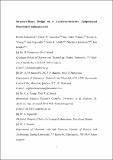Structure-based design of a eukaryote-selective antiprotozoal fluorinated aminoglycoside
View/
Date
10/08/2018Author
Funder
Grant ID
MR/M020118/1
Keywords
Metadata
Show full item recordAbstract
Aminoglycosides (AG) are antibiotics that lower the accuracy of protein synthesis by targeting a highly conserved RNA helix of the ribosomal A-site. The discovery of AGs that selectively target the eukaryotic ribosome, but lack activity in prokaryotes, are promising as antiprotozoals for the treatment of neglected tropical diseases, and as therapies to read-through point-mutation genetic diseases. However, a single nucleobase change A1408G in the eukaryotic A-site leads to negligible affinity for most AGs. Herein we report the synthesis of 6-fluorosisomicin, the first 6-fluorinated aminoglycoside, which specifically interacts with the protozoal cytoplasmic rRNA A-site, but not the bacterial A-site, as evidenced by X-ray co-crystal structures. The respective dispositions of 6-fluorosisomicin within the bacterial and protozoal A-sites reveal that the fluorine atom acts only as a hydrogen-bond acceptor to favorably interact with G1408 of the protozoal A-site. Unlike aminoglycosides containing a 6-ammonium group, 6-fluorosisomicin cannot participate in the hydrogen-bonding pattern that characterizes stable pseudo-base-pairs with A1408 of the bacterial A-sites. Based on these structural observations it may be possible to shift the biological activity of aminoglycosides to act preferentially as antiprotozoal agents. These findings expand the repertoire of small molecules targeting the eukaryotic ribosome and demonstrate the usefulness of fluorine as a design element.
Citation
Kanazawa , H , Saavedra , O M , Maianti , J P , Young , S A , Izquierdo , L , Smith , T K , Hanessian , S & Kondo , J 2018 , ' Structure-based design of a eukaryote-selective antiprotozoal fluorinated aminoglycoside ' , ChemMedChem , vol. 13 , no. 15 , pp. 1541-1548 . https://doi.org/10.1002/cmdc.201800166
Publication
ChemMedChem
Status
Peer reviewed
ISSN
1860-7179Type
Journal article
Description
This work was supported by Grant‐in‐Aid for Young Scientists (B) (No. 26860025) and Grant‐in‐Aid for Scientific Research (C) (No. 17K08248) from the Ministry of Education, Culture, Sports, Science and Technology, Japan (MEXT), and partially supported by the Kurata Grant awarded by the Kurata Memorial Hitachi Science and Technology Foundation, the grant provided by the Ichiro Kanehara Foundation and the Platform for Drug Discovery, Informatics, and Structural Life Science from Japan Agency for Medical Research and Development (AMED). H.K. was supported by the Sasakawa Scientific Research Grant from the Japan Science Society and the SUNBOR Scholarship. We thank the Photon Factory for provision of synchrotron radiation facilities (Photon Factory Proposal No. 2014G532) and acknowledge the staff of the NW‐12A and BL‐17A beamlines. We thank our colleague Vu Linh Ly for preparing the hydroxysisomicin intermediate. The Montreal group thanks NSERC for financial support and a fellowship to J.P.M. from the Québec Research Fund: Nature and Technology. The T.K.S. group thanks the Medical Research Council (MR/M020118/1) for current financial support.Collections
Items in the St Andrews Research Repository are protected by copyright, with all rights reserved, unless otherwise indicated.

